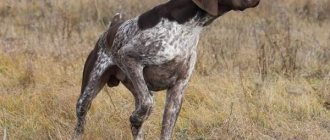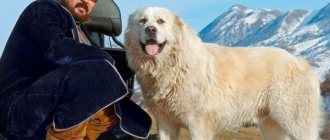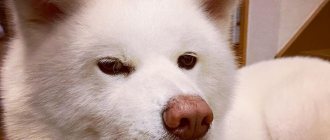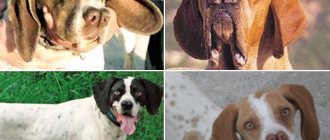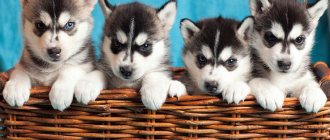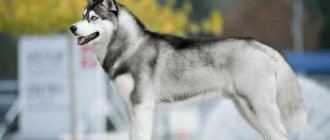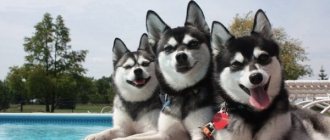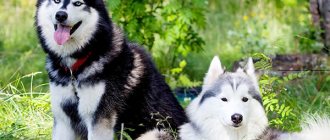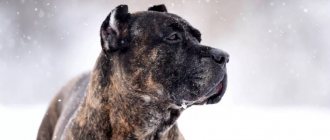There is a stereotype according to which a dog:
- best friend;
- security guard;
- a protector with whom it is not scary to let your child leave home.
Is this always the case? Of course, if you take one hundred dogs (not huskies ), the first ones we met on the street, and check, then the average dog will protect (and it’s not a fact that you will remain unharmed after such an experiment). But if we are talking about a specific dog, not only the instincts inherent in all canines and upbringing play a role, but also genetics and the history of the breed.
Features of sled dogs
Not every animal can be harnessed. To pull a sleigh through the snow, the dog must have, as they write in the resume, “communication skills, resistance to stress, the ability to work in a team and focus on results.” In addition, the riding northerner is required to:
- the ability to make decisions independently in case she sees a crack in the ice that is not noticeable to the musher;
- goodwill towards people and brothers - “colleagues” should calmly run together in a team, and not find out who is in charge;
- lack of devotion to one person and an acute reaction to a change of owner - no one needs a sled dog that has been “worked together” with only one driver.
It is these qualities that were historically consolidated in northern animals during the process of breeding. We love our dogs for their cheerful disposition, non-conflict and willfulness (some dog trainers believe that huskies are difficult to train, but this is not a matter of stupidity, but of the desire to make decisions for themselves). However, we must take these character traits into account before getting a dog, and understand what the sled breed is not capable of.
Animal speed
If we take into account the speed qualities of purebred Huskies, then in 2010 in the race a team of Siberian Huskies came 42 out of 55 in 11 days 20 hours 39 minutes 11 seconds, while the record time for the winner was: 8 days 23 hours 59 minutes 9 seconds.
Siberian Huskies will never win a sprint race, but at middle distances and above they will emerge victorious if they prepare on par with Alaskan Huskies, who are leaders in sports races. They can reach speeds of 15-20 km/h, while Alaskan ones reach speeds of 18-30 km/h.
Despite its friendliness and intelligence, Husky is not as simple as it seems . She has a very willful and independent character. It is difficult to train and it is simply impossible to use the carrot or stick system.
For her, you need to become an authority and a leader so that she starts following commands. And if a person himself is weak-willed, he will not succeed in raising such a dog and will not earn its trust and obedience.
If you don’t train and leave it to chance, the dog will get mad and play pranks. He cannot be punished too much, he is stubborn, it is better to divert his attention and cheer him up with love and affection and persistence. And, of course, physical activity should bring him to the point of fatigue and then he will become pliable. Everything will depend on how they can raise him.
Do Huskies protect their owner?
Unfortunately no. They are devoid of aggression towards people and are very friendly (sometimes even too friendly). Huskies can frighten a person if he is not aware of their characteristics and mistakes barking for a threat, but protection from them.
If a robber attacks you, the husky will bark, but what is happening will seem more like a game to her - she will not understand that the owner needs to be protected . The husky will not attack the enemy and is unlikely to bite him, but will behave actively, jump and, perhaps, try to lick his face. This behavior often frightens young children and parents, who mistake emotionality for anger and a desire to harm. This is not so: the animals are sincerely happy to play, they just (especially young ones) do not know how to calculate strength.
Natural Hunter Instincts
Another important point that makes huskies excellent hunting assistants is the peculiarities of their breeding among northern peoples. To this day, the tradition of feeding northern dogs only in the winter season has been preserved. At the same time, from the very beginning of spring and the melting of snow until late autumn, huskies are left to their own devices. This means that they have to get food on their own, literally looking for pasture, which confuses some owners who keep huskies in apartments.
When walking, the dog begins to pick up everything it can find on the ground, rightfully considering it its prey. Huskies need to be weaned from such actions in early childhood, otherwise it will become extremely difficult in the future.
This approach fully demonstrates the action of natural selection - for the sake of survival, northern dogs have to actively use their instincts as much as possible, and next to the instinct of searching for food, the ancient hunting instinct always goes hand in hand. The latter, by the way, was inherited by the husky (as well as other breeds) from a common ancestor - the wolf. Typically, this free-fed breed feeds on field mice and small birds, but northerners mention cases when huskies independently drove and ate even hares.
Can a Husky guard?
Unlikely. As in the case of the need for protection , the husky will not understand that you need to show aggression, and will not attack someone who is encroaching on your property. The most a husky can do is give a voice. However, this can be useful because it will attract your attention. Perhaps thanks to this you can prevent theft yourself.
The mount cannot be kept on a leash. This kind of content is not suitable for any dogs at all. If you want your pet to have a healthy psyche, not get sick and be cheerful, forget about chains. Freedom-loving and sociable breeds suffer from tethering even more than other dogs, perceiving it as punishment, inattention, or dislike from the owner.
Sled dogs are sometimes used to protect territory at rest. Their main goal is to draw people’s attention to an encroachment on their place (however, this rarely happens). If you set up a camp on a hike and want your husky to protect it, you need to clearly make it clear to the dog where the border of your territory is, beyond which strangers cannot go.
Working individuals in the North
Siberian Huskies are divided conventionally: working, racing, exhibition . “Workhorses” is how these dogs are characterized. Initially they were trained for these purposes. These are smart and unpretentious animals, very hardy and fast.
Huskies carried mail, firewood, meat, and fish, therefore, all those cargoes that helped a person survive in the conditions of the far north. In some villages, dogs that may be direct descendants of modern Huskies are still bred and exploited in Chukotka. Of course, American breeders were more concerned with preserving the exterior of the dogs, which is why they lost their working qualities.
Anyone trying to keep this breed at home must understand the need for physical activity for this dog. He can be a wonderful hiking companion in the summer and even a sleigh ride in the winter.
Is it possible to raise a Husky puppy to be a protector?
Of course you can try. But training a dog intended for service purposes is different from raising a regular pet. The security and protection includes exercises that instill a wary, unfriendly attitude towards strangers, and in some cases, aggression directed at them, which is not characteristic of huskies .
Such protection training is contrary to the very nature of the husky. Attempts to train sled dogs to be security guards end, as a rule, in nothing at best, and at worst - in obtaining a mentally unstable animal with an explosive temperament, prone to sudden manifestations of anger. Husky is a strong enough and trained dog for these experiments to be dangerous.
What else can they do?
The Eskimos always kept their sled dogs outside and only brought them into the house during the birth of a child. They did this in order to warm the child in extreme cold. The pack warmed the child, hence the friendliness of this dog, which would never, under any circumstances, bite a person. Thus, the Eskimos trusted dogs with the most important thing - their offspring.
Breeders do not stand still; they are constantly working on developing certain qualities of dogs, improving their characteristics. There are such varieties of Husky breeds:
- Mini Husky (Klee Kai) is a domestic dog.
- Alaskan Husky.
- The Sakhalin is a rare breed of sled dog.
- Siberian - for exhibitions and racing competitions.
- Japanese (Akita Inu) – guard.
Summing up
It will be better if you study information about the breed before purchasing an animal. Alas, there are often cases when a person who has already become the owner of a husky or malamute wonders whether his pet to protect his home and property. Having learned the answer, the owner becomes upset and either loses interest in the dog, ceasing to properly care for it and pay attention to it, or begins trying to re-educate it. Such attempts are doomed to failure, and you are doomed to disappointment.
Huskies are great friends and tireless fun. Even in urban conditions, a sled dog becomes the life of the party, and if you take it on hikes and engage in joint sports, you won’t find a happier animal. the husky qualities necessary to protect and guard her owners .
- training
- Husky
If you find an error, please select a piece of text and press Ctrl + Enter.
Learning ability
The initial training of a husky consists of the puppy learning its name and approaching the owner's call. Once your pet has mastered the exercises, introduce more challenging elements.
Huskies are stubborn and difficult to train.
The nuances of properly raising a dog at home on the site:
- In the house, define areas where the puppy is allowed to be and fence them off with drywall.
- Teach your puppy to use a diaper or litter box. After feeding, take him to a place to relieve himself and hold him there for a couple of minutes. If the puppy goes to the toilet, praise it.
- Be consistent in training - having given a command, force the dog to carry it out with the help of treats or mechanical influence.
- Do not punish your child for wrong actions - instead, develop him and methodically practice commands.
Don't allow yourself to shout at your dog - loud noises will make him go into a stupor.
Siberian Husky: photo, description of the breed, character, reviews
Health problems
Those wishing to buy a husky need to know that in addition to common infectious diseases, the following problems may occur:
- Baldness on the scalp, accompanied by itching, is associated with a deficiency of zinc in the body. The problem can be solved quite easily by contacting a veterinarian and giving food preparations containing microelements.
The breed often encounters problems associated with eye diseases such as cataracts, retinal degeneration and atrophy, glaucoma, and abnormal processes in the sclera, the causes of which are hereditary. What you need to pay attention to when choosing a puppy.
- Eczematous phenomena on the skin associated with the dog's thick coat. More often it manifests itself in the form of weeping eczema, especially in the hot season. To prevent this, it is necessary to comb the dog thoroughly, and if the disease has already manifested itself, the help of a veterinary specialist is necessary.
- Thyroid gland dysfunction is manifested by various symptoms: increased fatigue, deterioration of coat quality, lethargy, drowsiness, infertility, poor general condition and others. For diagnosis, a biochemical blood test is performed.
- Quite often among male dogs there are cryptorchids (one of the testes does not descend into the scrotum and remains in the abdominal cavity). This problem is fraught with the formation of tumor-like inguinal hernia formations in the undescended testis. Diagnosed by examination and palpation by a veterinarian. If detected, castration is recommended.
- Due to increased emotionality, huskies have a hereditary predisposition to the development of such a serious disease as epilepsy. You need to pay attention to this when choosing a puppy (the health status of the parents and grandparents).
Behavior and character
The breed can be called the ideal of ideas about true friendship.
Having a balanced psyche allows a family with small children to live safely in a home.
Living in a city apartment will not create any inconvenience. Knowing one's place and coming to terms with the limitations of freedom.
Socializing a dog from an early age will undermine the quality of protection of a private home, but will teach it to communicate.
The need for physical activity determines daily active walks in any weather.
The breed is more suitable for young people who are able to take walks to the fullest.
External characteristics of the breed:
- height 60 cm;
- weight from 15 to 28 kg;
- elongated eye shapes, blue or brown shades of the iris;
- small, close-set ears, straight;
- small proportional head;
- muzzle equal to the length of the skull;
- pigmented lips, tightly fitting;
- strong, deep chest;
- fox tail type;
- medium length coat, with undercoat;
- various colors.
A good Husky dog shows itself at an early age. Physical formation is achieved by 3 years of life.
Basic care
Clean pets of impressive size and owners of luxurious fur. Puppies easily get used to the necessary brushing and bathing.
Regular dental examinations, preventative measures, and ear and eye cleaning are necessary.
Adequate nutrition is the key to health. There is a tendency to overeat. Consultation with a veterinarian is required.
The advantage is considered to be low salivation and excellent immunity. Diseases arise from improper care or from hereditary data. The pet can live up to 15 years.
Education and training
An activity for persistent and self-confident people. To achieve success, especially to protect private households, you will have to work hard.
Education begins with the establishment of behavior in the pack. The time it takes to learn the rules of what is allowed and what is prohibited depends entirely on the owner.
Trust training may be an excellent option for children 12-14 years old, but not earlier.
